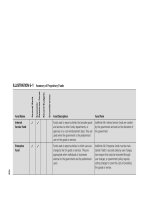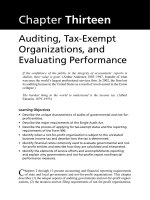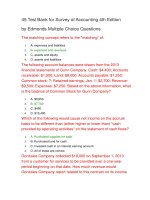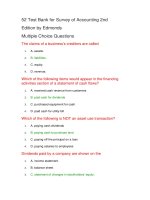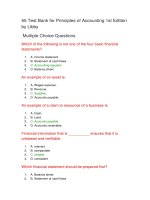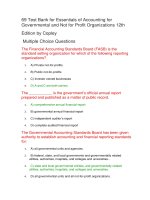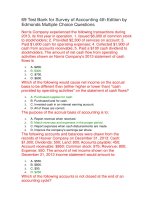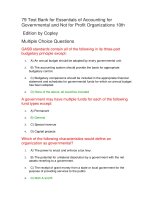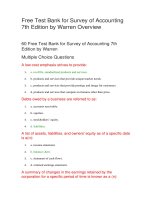Test bank and solution of accounting and financial report (2)
Bạn đang xem bản rút gọn của tài liệu. Xem và tải ngay bản đầy đủ của tài liệu tại đây (288.71 KB, 13 trang )
Chapter 02 - Principles of Accounting and Financial Reporting for State and Local Governments
CHAPTER 2:
PRINCIPLES OF ACCOUNTING AND FINANCIAL
REPORTING FOR STATE AND LOCAL
GOVERNMENTS
OUTLINE
Number
Topic
Type/Task
Status
(re: 16/e)
Questions:
2-1
2-2
2-3
2-4
2-5
2-6
2-7
2-8
2-9
2-10
Service activities categories
Reporting objectives
Modified accrual accounting
Fund categories
Purpose of funds
Deferred inflows and outflows of resources
Expenses/Expenditures
Proprietary fund accounting
Fund balance classifications
Major fund criteria
Identify
Describe
Explain
Identify
Explain
Define
Identify
Explain
Identify
Identify
New
New
New
Revised
New
New
New
New
New
Same
Cases:
2-11
2-12
2-13
Accounting and reporting principles
Evaluation of basic financial statements
Fund balance classifications
Analysis
Evaluate
Describe
Revised
Same
New
Exercises/Problems:
2-14
Examine the CAFR
2-15
Various
Examine
Multiple Choice
2-16
2-17
Identify
Match
Revised
Items 1,3, 5,
and 6 are
new; other
items are
same
2-4
2-5 revised
Match
Analyze
Analysis; calculate
2-6
9-5 revised
2-7
2-18
2-19
2-20
Matching fund types with fund categories
Matching government-wide and fund financial
reporting characteristics
Matching transactions with funds
Fund balance classifications
Determination of major funds
2-1
© 2013 by McGraw-Hill Education. This is proprietary material solely for authorized instructor use. Not authorized for sale or distribution in any
manner. This document may not be copied, scanned, duplicated, forwarded, distributed, or posted on a website, in whole or part.
Chapter 02 - Principles of Accounting and Financial Reporting for State and Local Governments
CHAPTER 2:
PRINCIPLES OF ACCOUNTING AND FINANCIAL
REPORTING FOR STATE AND LOCAL
GOVERNMENTS
Answers to Questions
2-1.
The three categories of broad service activities of a general purpose government are
governmental, business-type, and fiduciary. Governmental activities include
administrative support and core government services. Business-type activities are
activities that are generally intended to be self-supporting, such as public utilities.
Fiduciary activities are those where the government acts as a trustee or agent for parties
outside the government.
General Problem Information: Service activities categories
Learning Objective: 2-1
Topic: Activities of Government
Bloom’s Taxonomy: Remember
Accreditation Skills tag: AACSB: Communication, AICPA: BB Industry
Level of Difficulty: Easy
2-2.
The primary objective of government-wide financial reporting is to report on the
government’s operational accountability so that users can evaluate whether the
government is covering the cost of its services over the long run. Additionally, recall
from Chapter 1 that operational accountability relates to how efficiently and effectively
the government is using its resources in meeting its objectives. The objective of
governmental fund financial reporting is to report on the government’s fiscal
accountability. Thus, governmental fund financial reporting helps users evaluate the short
run objective of whether financial resources were raised and spent in accordance with
legal and budgetary restrictions. As can be seen from the objectives, the focus of the
government-wide statements tends to be more long run and related to cost of services;
whereas, the governmental fund financial statements tends to be short run and related to
whether costs for services were incurred in accordance with restrictions.
General Problem Information: Reporting objectives
Learning Objective: 2-2
Topic: Financial Reporting Model
Bloom’s Taxonomy: Understand
Accreditation Skills tag: AACSB: Communication, AICPA: BB Industry
Level of Difficulty: Medium
2-3.
The modified accrual basis of accounting records revenues when they are measurable and
available for use in paying current period obligations, while expenditures are recorded
when an obligation has been incurred that will be paid from current financial resources.
Because governmental fund financial statements focus on fiscal accountability, this basis
of accounting allows for a focus on current sources and uses of financial resources as
opposed to the more long-term view provided by accrual accounting.
2-2
© 2013 by McGraw-Hill Education. This is proprietary material solely for authorized instructor use. Not authorized for sale or distribution in any
manner. This document may not be copied, scanned, duplicated, forwarded, distributed, or posted on a website, in whole or part.
Chapter 02 - Principles of Accounting and Financial Reporting for State and Local Governments
Ch. 2, Answers, Question 2-3 (Cont’d)
General Problem Information: Modified accrual accounting
Learning Objective: 2-2
Topic: Financial Reporting Model
Bloom’s Taxonomy: Understand
Accreditation Skills tag: AACSB: Communication, AICPA: FN Reporting
Level of Difficulty: Medium
2-4.
The three categories of funds are governmental, proprietary, and fiduciary. The fund
types included in each category are shown below:
Governmental
General Fund
Special revenue funds
Debt service funds
Capital projects funds
Permanent funds
Proprietary
Enterprise funds
Internal service funds
Fiduciary
Agency funds
Investment trust funds
Pension (and other
employee benefit) trust
funds
Private-purpose trust
funds
The basis of accounting used by governmental funds is modified accrual. Proprietary
funds use the accrual basis of accounting as do fiduciary funds.
General Problem Information: Fund categories
Learning Objective: 2-2
Topic: Financial Reporting Model
Bloom’s Taxonomy: Remember
Accreditation Skills tag: AACSB: Communication, AICPA: FN Reporting
Level of Difficulty: Easy
2-5.
Governmental accounting systems must provide both reporting in accordance with GAAP
and reporting to determine and demonstrate compliance with finance-related legal and
contractual requirements. To ensure that both GAAP and compliance reporting
requirements are met, a separate accounting mechanism is used. The mechanism that is
used is fund accounting, which makes it possible to ensure that the compliance reporting
requirement is met.
A fund is a separate reporting entity that may be established by imposition of grant or
contract provisions by external parties, by constitutional provisions or legislation, or by
discretionary action of the reporting government.
General Problem Information: Purpose of funds
Learning Objective: 2-2
Topic: Financial Reporting Model
Bloom’s Taxonomy: Understand
2-3
© 2013 by McGraw-Hill Education. This is proprietary material solely for authorized instructor use. Not authorized for sale or distribution in any
manner. This document may not be copied, scanned, duplicated, forwarded, distributed, or posted on a website, in whole or part.
Chapter 02 - Principles of Accounting and Financial Reporting for State and Local Governments
Ch. 2, Answers, Question 2-5 (Cont’d)
Accreditation Skills tag: AACSB: Communication, AICPA: FN Reporting
Level of Difficulty: Medium
2-6.
Deferred outflows of resources are resources that have been consumed but are applicable
to a future reporting period (e.g., costs related to a debt refunding). Deferred outflows
increase net position. Deferred inflows of resources are resources that have been acquired
but are applicable to a future period (e.g. resources received but unavailable for use until
a future period). Deferred inflows decrease net position. These accounts, used only when
required by a GASB standard, represent timing differences between the actual outflow or
inflow of cash and the time period to which they apply.
General Problem Information: Deferred inflows and outflows of resources
Learning Objective: 2-2
Topic: Financial Reporting Model
Bloom’s Taxonomy: Remember
Accreditation Skills tag: AACSB: Communication, AICPA: FN Reporting
Level of Difficulty: Easy
2-7
Expenditures report actual outlays of funds, whether for an operating cost or the purchase
of an asset. Expenses focus on costs necessary to generate revenues or fund operations,
and may be a result of the using up or expiration of an asset, even if no cash was paid out.
General Problem Information: Expenses/Expenditures
Learning Objective: 2-2
Topic: Financial Reporting Model
Bloom’s Taxonomy: Remember
Accreditation Skills tag: AACSB: Communication, AICPA: FN Reporting
Level of Difficulty: Easy
2-8.
Both enterprise funds and internal service funds are classified as proprietary funds. These
two types of funds are operated in a manner similar to for-profit businesses. The reasons
they are operated similar to for-profit businesses is because of the types of customers they
serve and the fact that they are largely self-supporting. Enterprise funds are used for
activities where services are provided to and paid for by the public. Internal service funds
are used for centralized types of activities, where services are provided to and reimbursed
by other governmental units.
General Problem Information: Proprietary fund accounting
Learning Objective: 2-2
Topic: Financial Reporting Model
Bloom’s Taxonomy: Understand
2-4
© 2013 by McGraw-Hill Education. This is proprietary material solely for authorized instructor use. Not authorized for sale or distribution in any
manner. This document may not be copied, scanned, duplicated, forwarded, distributed, or posted on a website, in whole or part.
Chapter 02 - Principles of Accounting and Financial Reporting for State and Local Governments
Ch. 2, Answers, Question 2-8 (Cont’d)
Accreditation Skills tag: AACSB: Communication, AICPA: FN Reporting
Level of Difficulty: Medium
2-9.
The fund balance classifications and an example for each are provided below. There are
numerous examples of what could be included in each classification; therefore,
consideration should be given to whether the student’s answer appropriately fits the
definition for the fund balance classification.
Nonspendable: This would include items such as endowments and prepaids (including
inventory).
Spendable-restricted: This would include items restricted by those outside of
government, such as operating and capital grants that can be used only for specific
purposes, resources restricted by contractual arrangements such as debt proceeds.
Spendable-committed: This would include items that the governing body has set aside
as a result of formal action, such as items related to capital acquisition/construction or
operations (specific activities).
Spendable-assigned: These are items that the government intends to use for specific
purposes, and could include items similar to those found under committed fund balances.
Additionally, it would include any fund balances in special revenue, capital projects, debt
service or permanent funds that have not been identified as nonspendable, restricted or
committed.
Spendable-unassigned: This would be the balance in the General Fund that has not been
identified as nonspendable, restricted, committed or assigned.
General Problem Information: Fund balance classifications
Learning Objective: 2-2
Topic: Financial Reporting Model
Bloom’s Taxonomy: Remember
Accreditation Skills tag: AACSB: Communication, AICPA: FN Reporting
Level of Difficulty: Easy
2-10. The GASB requires that any fund that meets the following relative size criteria be
designated as major:
a.
b.
Total assets, liabilities, revenues or expenditures/expenses of that governmental or enterprise fund are
at least 10 percent of the corresponding element total (assets, liabilities, and so forth) for all funds of
that category or type (that is, total governmental or total enterprise funds), and (emphasis added)
The same element that met the 10 percent criterion in (a) is at least 5 percent of the corresponding
element total for all governmental and enterprise funds combined.
In addition to funds that meet these two criteria, the General Fund of a state or local
government must always be reported as a major fund. Finally, at its discretion
management can report as a major fund any other governmental or enterprise fund that it
considers of significant importance to financial statement users.
2-5
© 2013 by McGraw-Hill Education. This is proprietary material solely for authorized instructor use. Not authorized for sale or distribution in any
manner. This document may not be copied, scanned, duplicated, forwarded, distributed, or posted on a website, in whole or part.
Chapter 02 - Principles of Accounting and Financial Reporting for State and Local Governments
Ch. 2, Answers, Question 2-10 (Cont’d)
General Problem Information: Major fund criteria
Learning Objective: 2-3
Topic: Major Funds
Bloom’s Taxonomy: Remember
Accreditation Skills tag: AACSB: Communication, AICPA: FN Reporting
Level of Difficulty: Easy
Solutions to Cases
2-11. A quick look at these financial statements reveals that Ms. Ramirez, while familiar with
not-for-profit reporting, has almost no knowledge of GASB reporting requirements.
Let’s analyze these financial statements from the viewpoint of (a) a local CPA who is
considering auditing the town’s financial statements and (b) a member of the town
council or a citizen.
a. As a CPA knowledgeable about governmental accounting, you should see many red
flags regarding the financial statements. Do the financial statements that Ms.
Ramirez has prepared conform to GAAP? The short answer is no. To determine
why the statements do not conform you need only analyze them relative to the
information in this chapter and the government-wide and fund financial statements
prepared by governments conforming to GASB standards, such as those prepared by
the City and County of Denver (see Illustrations A2-1 through A2-11). Among the
many problems you should detect (although you may miss many of these problems at
this early point in the course) are the following.
1. The town does not present separate government-wide and fund financial
statements, although with a little work the balance sheet could be converted into a
government-wide statement of net position.
2. Since the government has both governmental and an enterprise fund, activities at
the government-wide level are required to be separated into governmental
activities and business-type activities. See Illustration A2-1 for an example.
3. At the fund level the financial statements will need to provide separate columns
for the General Fund activity and the major/nonmajor fund activity (in this case
the Road Tax Fund). See Illustration A2-3 for an example.
4. At the government-wide level there would be no net asset information; it would
be net position information. Additionally, the net position information would
need to identify net position-restricted (there is no temporarily restricted
classification) and net position-net investment in capital assets.
2-6
© 2013 by McGraw-Hill Education. This is proprietary material solely for authorized instructor use. Not authorized for sale or distribution in any
manner. This document may not be copied, scanned, duplicated, forwarded, distributed, or posted on a website, in whole or part.
Chapter 02 - Principles of Accounting and Financial Reporting for State and Local Governments
Ch. 2, Solutions, Case 2-11 (Cont’d)
5. Because no fund financial statements are prepared, key information such as
nonspendable, restricted, committed, assigned, and unassigned fund balances of
the General Fund (see Illustration A2-3, for example) and the Road Tax Fund are
not presented.
6. The statement of activities is not in the cost of services format recommended by
GASB, where the expenses are adjusted for program revenues (such as charges
for services) to determine the net expenses from which general revenues (such as
taxes) are deducted (see Illustration A2-2, for example). The change reflected on
the statement of activities is a change in net position, not net assets as reported by
Ms. Ramirez.
7. Budget and actual comparison information is not presented as required, either as
basic statements or required supplementary information schedules (see Appendix
B at the end of Chapter 2).
8. Expense detail is lacking. More functional detail is needed under “Government
services,” such as general government, public safety, public works, and other
relevant functions, so the amounts expended for each service area can be
determined. Presumably, this would also reduce the relatively large amount
reported as “Miscellaneous.”
9. Why are accounts receivable relating to the Sewer Fund missing from the balance
sheet? Since the Sewer Fund is being operated as an enterprise fund, billings that
have not been collected at year-end should be reported. In addition, GAAP
requires accrual of a receivable and revenue for services provided but unbilled at
year-end.
10. Since the Sewer Fund is an enterprise fund, a statement of cash flows is required
for that fund.
11. Where are the notes to the financial statements? The notes are an integral part of
any set of financial statements.
12. Where is the MD&A—also required by GAAP?
Given the serious reporting deficiencies observed, it is likely the CPA would be
required to render an adverse opinion, since it appears that the financial statements do
not fairly present financial information in conformity with GAAP. Depending on the
quality of the town’s financial records, it is also possible that the CPA would have to
issue a disclaimer report due to missing or insufficient financial information. (Note:
You may wish to look at Chapter 11 for the meaning of adverse and disclaimed audit
reports.)
2-7
© 2013 by McGraw-Hill Education. This is proprietary material solely for authorized instructor use. Not authorized for sale or distribution in any
manner. This document may not be copied, scanned, duplicated, forwarded, distributed, or posted on a website, in whole or part.
Chapter 02 - Principles of Accounting and Financial Reporting for State and Local Governments
Ch. 2, Solutions, Case 2-11 (Cont’d)
b.
A member of the town council or a citizen of the town should be concerned as well
about several of the issues raised by the CPA in part a. Although the treasurer may
still be preparing statements of cash receipts and disbursements for each fund, the
lack of information about cost of services for governmental functions and sewer
operations should be of concern. Moreover, unless the town budgets on a cash basis,
the lack of GAAP-based fund statements results in a lack of full information about
available financial resources in the General and Road Tax Funds for budgeting
purposes. The lack of budget and actual comparison statements or schedules should
also be of concern to a member of the town council or a citizen.
General Problem Information: Accounting and reporting principles
Learning Objective: 2-2
Topic: Financial Reporting Model
Bloom’s Taxonomy: Analyze
Accreditation Skills tag: AACSB: Analytical Thinking, AICPA: FN Decision Making
Level of Difficulty: Hard
2-12. a.
Based on the description of this city’s financial statements in the MD&A, the
statements appear to conform very well to GASB standards. Specifically:
Government-wide Financial Statements
Include the two required financial statements—statement of net position and
statement of activities.
Use “accounting methods similar to those used by the private sector,” i.e.,
economic resources measurement focus and the accrual basis of accounting.
Report governmental and business-type activities in separate columns.
Fund Financial Statements
Provide detailed information about major funds. All nonmajor funds are
summarized and presented in a single column.
Report on three kinds (i.e., categories) of funds—governmental, proprietary, and
fiduciary.
Governmental funds are “prepared on a modified accrual basis, which means they
measure only current financial resources and uses.” Capital assets and other longlived assets, along with long-term liabilities, are not presented in the
governmental fund statements.
Proprietary funds include both enterprise and internal service funds, prepared on
the accrual basis and include all their assets and liabilities, current and long-term.
Fiduciary funds include activities that report trust responsibilities of the city.
“These assets are restricted in purpose and do not represent discretionary assets of
the city. Therefore, these assets are not presented as a part of the governmentwide financial statements.”
2-8
© 2013 by McGraw-Hill Education. This is proprietary material solely for authorized instructor use. Not authorized for sale or distribution in any
manner. This document may not be copied, scanned, duplicated, forwarded, distributed, or posted on a website, in whole or part.
Chapter 02 - Principles of Accounting and Financial Reporting for State and Local Governments
Ch. 2, Solutions, Case 2-12 (Cont’d)
b. This is a straightforward way of saying that the governmental fund information
focuses only on current financial resources, not all economic resources. As a result, it
is necessary to present a reconciliation of the governmental fund total fund balances
to the government-wide governmental activities net position and change in fund
balances to change in net position, as explained in Chapter 2 and shown in
Illustrations A2-4 and A2-6 for the City and County of Denver.
General Problem Information: Evaluation of basic financial statements
Learning Objective: 2-2
Topic: Financial Reporting Model
Bloom’s Taxonomy: Evaluate
Accreditation Skills tag: AACSB: Analytical Thinking, AICPA: FN Decision Making
Level of Difficulty: Easy
2-13. There are a variety of reasons for the amounts that have been provided for each fund
balance classification appearing on the governmental fund balance sheet for Denver.
Following are some of the reasons provided in the 2013 CAFR.
Nonspendable sources: The majority of the nonspendable fund balance appears in the
Other Governmental Funds column. A large portion of the balance appearing in the Other
Governmental Funds column is related to endowment (permanent fund). The remaining
nonspendable balance is prepaid assets.
Restricted sources: Most of the functions of the government (General Government,
Public Safety, Public Works, Human Services, Health, Parks and Recreation, among
others) have received restricted resources. Fund balances are restricted for a variety of
reasons having to do with the many sources from which the amounts were received. The
external sources that are contributing to the restricted fund balance amounts include
operating (special projects) and capital grants, bond proceeds, special assessments,
foreclosed assets (Special Revenue Community Development fund) and restricted loans.
Committed sources: A number of governmental funds identify committed fund
balances. For the City and County of Denver it is the city council that has the authority to
commit funds. Funds have been committed for a variety of capital (fixed asset) projects.
Fund balances have also been committed for park maintenance, crime prevention,
business incentives and community projects.
Assigned sources: The City and County of Denver allows the Budget and Management
Office, in addition to the City Council, to assign fund balances. Although the notes
identify assigned fund balances by government function (General Government, Public
Safety, Public Works, Parks and Recreation, and Cultural Activities), the purpose for
which the funds have been assigned is unclear. No specific sources for the amounts listed
have been identified as assigned.
2-9
© 2013 by McGraw-Hill Education. This is proprietary material solely for authorized instructor use. Not authorized for sale or distribution in any
manner. This document may not be copied, scanned, duplicated, forwarded, distributed, or posted on a website, in whole or part.
Chapter 02 - Principles of Accounting and Financial Reporting for State and Local Governments
Ch. 2, Solutions, Case 2-13 (Cont’d)
General Problem Information: Major Fund Criteria
Learning Objective: 2-2
Topic: Financial Reporting Model
Bloom’s Taxonomy: Understand
Accreditation Skills tag: AACSB: Communication, AICPA: FN Reporting
Level of Difficulty: Medium
Solutions to Exercises and Problems
2-14. Each student should have a different governmental annual report, so will have different
answers to questions in this exercise. We suggest allowing students to discuss their
answers, which will give them an idea of the range of the answers of other students.
General Problem Information: Examine the CAFR
Learning Objective: 2-2
Topic: Financial Reporting Model
Bloom’s Taxonomy: Remember
Accreditation Skills tag: AACSB: Communication, AICPA: FN Reporting
Level of Difficulty: Easy
2-15. 1.
2.
3.
4.
5.
a.
d.
c.
a.
b.
6.
7.
8.
9.
10.
d.
b.
c.
c.
b.
General Problem Information: Various
Learning Objective: 2-1
Learning Objective: 2-2
Learning Objective: 2-3
Topic: Various chapter topics
Bloom’s Taxonomy: Understand
Accreditation Skills tag: AACSB: Communication, AICPA: BB Industry
Level of Difficulty: Medium
2-16. Agency fund
Permanent fund
Debt service fund
Internal service fund
Pension (and other employee
benefit) trust fund
Special revenue fund
Enterprise fund
General Fund
FF
GF
GF
PF
FF
GF
PF
GF
2-10
© 2013 by McGraw-Hill Education. This is proprietary material solely for authorized instructor use. Not authorized for sale or distribution in any
manner. This document may not be copied, scanned, duplicated, forwarded, distributed, or posted on a website, in whole or part.
Chapter 02 - Principles of Accounting and Financial Reporting for State and Local Governments
Ch. 2, Solutions, Exercise 2-16 (Cont’d)
Investment trust fund
Capital projects fund
Private-purpose trust fund
FF
GF
FF
General Problem Information: Matching fund types with fund categories
Learning Objective: 2-2
Topic: Financial Reporting Model
Bloom’s Taxonomy: Remember
Accreditation Skills tag: AACSB: Communication, AICPA: FN Reporting
Level of Difficulty: Easy
2-17.
1.
2.
3.
4.
Governmental funds
Proprietary funds
Fiduciary funds
Governmental activities,
government-wide
5.
Business-type activities,
government-wide
b, e, f, i
a, d, g, h, j
a, c, g, k
a, g, h, j (Note: Internal service fund information
is typically reported in governmental activities using the same
measurement focus and basis of
accounting.)
a, g, h, j (Note: Internal service fund information
may be reported as part of
business-type activities if the
internal service activity primarily
supports an enterprise activity)
General Problem Information: Matching government-wide and fund financial reporting
characteristics
Learning Objective: 2-2
Topic: Financial Reporting Model
Bloom’s Taxonomy: Understand
Accreditation Skills tag: AACSB: Communication, AICPA: FN Reporting
Level of Difficulty: Medium
2-18.
1.
2.
3.
4.
5.
6.
h.
a.
j.
g.
d.
b.
7.
8.
9.
10.
11.
e.
i.
f.
c.
k.
2-11
© 2013 by McGraw-Hill Education. This is proprietary material solely for authorized instructor use. Not authorized for sale or distribution in any
manner. This document may not be copied, scanned, duplicated, forwarded, distributed, or posted on a website, in whole or part.
Chapter 02 - Principles of Accounting and Financial Reporting for State and Local Governments
Ch. 2, Solutions, Exercise 2-18 (Cont’d)
General Problem Information: Matching transactions with funds
Learning Objective: 2-2
Topic: Financial Reporting Model
Bloom’s Taxonomy: Understand
Accreditation Skills tag: AACSB: Communication, AICPA: FN Reporting
Level of Difficulty: Medium
2-19.
1.
2.
3.
4.
5.
d.
c.
a.
d.
b.
General Problem Information: Fund balance classifications
Learning Objective: 2-2
Topic: Financial Reporting Model
Bloom’s Taxonomy: Analyze
Accreditation Skills tag: AACSB: Analytical Thinking, AICPA: FN Decision Making
Level of Difficulty: Hard
2-20.
DATE:
MEMO TO:
FROM:
RE:
xxx
City Manager, Forest City
Independent Auditor
Major Special Revenue Funds
As shown by the blue shading in the calculations provided below, only the
Housing and Urban Development Grant must be reported as a major fund.
Neither the Gas Tax Revenue Fund nor the Forest City Library Fund meets the
GASB threshold for major fund reporting; that is, none of the four elements of
those funds (assets, liabilities, revenues, or expenditures) is at least 10% of the
corresponding total of all governmental funds and at least 5% of the
corresponding total of all governmental and enterprise funds. Both total assets
and total revenues of the Housing and Urban Development Grant meet the 10
percent of all governmental funds and 5 percent of all governmental and
enterprise funds combined criteria. Although the Gas Tax Revenue Fund did not
meet the criteria for major fund reporting, rapidly escalating gas taxes tied to the
current high price of gasoline might warrant reporting this fund as a major fund to
improve accountability to citizens. GASB standards permit government officials
to designate any governmental or enterprise fund as a major fund if, in their
judgment, the fund is of sufficient importance to warrant designation as a major
fund.
2-12
© 2013 by McGraw-Hill Education. This is proprietary material solely for authorized instructor use. Not authorized for sale or distribution in any
manner. This document may not be copied, scanned, duplicated, forwarded, distributed, or posted on a website, in whole or part.
Chapter 02 - Principles of Accounting and Financial Reporting for State and Local Governments
Ch. 2, Solutions, Exercise 2-20 (Cont’d)
Calculation of Major Fund Thresholds
Gas Tax Revenue Fund
>5% of
>10% of
GovernFinancial
Governmental and
Statement
mental
Enterprise
Elements
Funds
Funds
Assets
Yes-10.3% No-4.6%
Liabilities
No-8.4%
No-4.9%
Revenues
No-9.0%
No-4.6%
Expenditures No-8.3%
No-4.6%
Housing and Urban
Development Fund
>5% of
>10% of
GovernGovernmental and
mental
Enterprise
Funds
Funds
Yes-11.2% Yes-5.01%
No-9.8%
Yes-5.7%
Yes-11.1% Yes-5.7%
No-8.7%
No-4.9%
Forest City
Library Fund
>5% of
>10% of
GovernGovernmental and
mental
Enterprise
Funds
Funds
No-6.5%
No-2.9%
No-0.0%
No-0.0%
No-7.8%
No-4.0%
No-8.0%
No-4.5%
General Problem Information: Determination of major funds
Learning Objective: 2-3
Topic: Major Funds
Bloom’s Taxonomy: Apply
Accreditation Skills tag: AACSB: Knowledge Application, AICPA: FN Decision
Making
Level of Difficulty: Hard
2-13
© 2013 by McGraw-Hill Education. This is proprietary material solely for authorized instructor use. Not authorized for sale or distribution in any
manner. This document may not be copied, scanned, duplicated, forwarded, distributed, or posted on a website, in whole or part.
